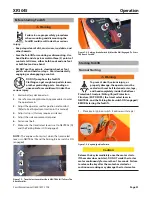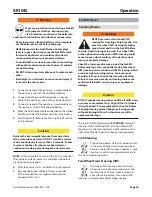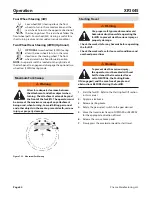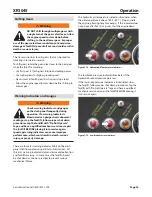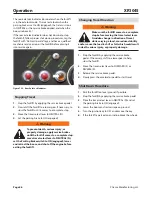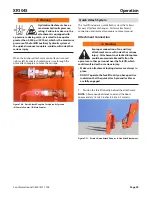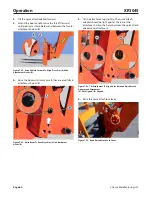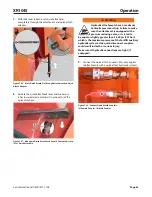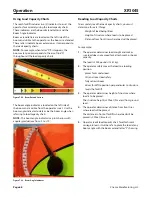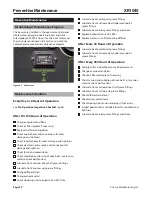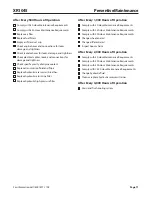
For information call (800) 497-1704
Page 65
XR1045
Operation
4.
Use the frame sway control to level the forklift For
additional information, refer to the Frame Leveling
section in this manual
5.
Align the forks at the level the load is to be placed
6.
Extend the boom slowly until the load is just above
the area where it is to be placed
7.
Lower the boom until the pallet rests in position and
the forks are free to retract
8.
Retract the forks slowly from under the load
Load Shift
1.
If the load shifts, stop the forklift immediately
2.
Lower and adjust the load to center its weight
3.
If the load shift is too great for adjustment, rearrange
the load before attempting to move the forklift
Elevating Personnel
Warning
Use only a compliant work platform to lift or lower
personnel. Never drive the vehicle with the work
platform in a raised position or with personnel on
board, even for a short distance. Doing so could result
in death, serious injury, or property damage.
Please refer to ANSI/ITSDF B56.6 for additional design
and operating information regarding elevating
personnel.
Design Requirements For A Personnel
Platform:
1)
Platform floor must having a slip resistant surface
located not more than 8” above the normal load
supporting surface of the fork
2)
Platform floor dimensions shall not exceed two times
the load center distance This floor dimension is measured
parallel to the longitudinal center plane of the vehicle
3)
Platform floor width shall not be greater than the
overall width of the vehicle, measured across the load
bearing tires, plus 10” on each side
4)
Minimum space requirements for each person on the
platform shall not be less than 18” in either direction
5)
4” minimum height toe plate around the perimeter of
the platform which may be omitted at the access opening
6)
On overhead protection device, when requested by the
user
7)
Protection must be provided for the personnel in their
normal working position on the platform from moving
parts of the rough terrain forklift that represent a hazard
8)
Information prominently indicated on the platform;
A)
Maximum work load including personnel and
equipment
B)
Weight of empty platform
9)
Provide a means so that the platform can only be
centered laterally on the rough terrain forklift truck and
retained against the vertical face of the forks, carriage, or
lifting mechanism
10)
Provide a means to securely attach the platform to
the lifting mechanism, and to prevent the platform from
inadvertent pivoting
11)
Provide restraining means for securing personnel
such as an anchorage for attaching the lanyard of a body
belt or harness
12)
Provide a guardrail or similar structure with a
nominal height to the platform floor of 42” around its
upper periphery and include a mid rail It may be hinged,
removable, or of chains, and used if proper positioning is
easily discernible Such restraining means shall be capable
of withstanding a concentrated horizontal force of 200 lbs
applied at the point of least resistance without permanent
deformation A body belt and lanyard is to have an
attachment point provided for freedom of movement, and
its length is limited to a free-fall of 5’ measured from the
point of attachment to the operator The complete system
shall be capable of withstanding three consecutive drop
tests to simulate a 250 lbs person free falling 6’ without
allowing the test weight to fall free to the ground A
deceleration device may be included
13)
Lanyards shall be arranged so as not to cause a
tripping hazard
14)
Body belts should have a width of a least 1 75”
15)
Structural safety factor – all load supporting structural
elements of the work platform shall have a structural
safety factor of not less than 2 to 1 based on the minimum
yield strength of the material used
Capacity Limitations:
The combined weight in pounds of the platform, load
and personnel shall not exceed 33% of the capacity of
the related load center position indicated on the machine
load chart

